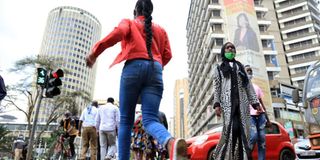Cities drive development

Members of the public going about their business on the streets of Nairobi in this photo taken on October 27, 2020.
What you need to know:
- Sustainable Development Goal (SDG) 11 is to make cities and human settlements inclusive, safe, resilient and sustainable.
- But urbanisation in Kenya is accompanied by increased pressure on the environment and accelerated demand for basic services, infrastructure, jobs, land and affordable housing.
Around 27 per cent of Kenyans live in urban areas and, with the country urbanising at about 4.3 percent a year, by 2050 about half of the population will be living in cities.
World Cities Day, due this Saturday, brings on urbanisation as a central issue for development and encourages co-operation among countries in meeting opportunities and addressing urban challenges to sustainable development.
Sustainable Development Goal (SDG) 11 is to make cities and human settlements inclusive, safe, resilient and sustainable. But urbanisation in Kenya is accompanied by increased pressure on the environment and accelerated demand for basic services, infrastructure, jobs, land and affordable housing.
The government has been undertaking large-scale infrastructure projects to improve connectivity between towns, scale up cities’ competitiveness and, in return, attract investments in urban areas.
Rapid development
Urban resilience is crucial to avoid human, social and economic losses while sustainability of urbanisation is vital to protect the environment and mitigate disaster risk and climate change.
Kenya can learn from Malaysia. One of the larger economies in South Asia, it underwent rapid development in the late 20th Century and, today, just less than one per cent of its households live in extreme poverty.
The World Bank projects Malaysia’s economy to transition from an upper middle-income to a high-income one by 2024.
Despite rapid industrialisation and urbanisation in Malaysia, environmental protection is given top priority. The country still has 62.3 per cent, or 20,456,000 hectares, of forest cover, according to teh Food and Agriculture Organisation (FAO). It is ranked in the top 12 countries in mega-biodiversity and fourth for having the most tree species.
Cities are increasingly becoming drivers of global prosperity. However, we must commit ourselves to realising the goal of sustainable urbanisation as a key lever for development.





